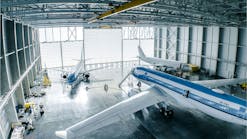LAS VEGAS, NEVADA--(Marketwire - Oct. 9, 2011) - NBAA - A pillar of the mid-size corporate jet sector - Pratt & Whitney Canada's (P&WC's) PW300 turbofan engine - celebrates its 20th anniversary this year, an industry leader with 3,500 engines produced in nine models and with more than 9 million hours of accumulated flight time. P&WC is a United Technologies Corp. company (NYSE:UTX).
"The roster of airframe OEMs who have selected the PW300 is impressive," says Mike Perodeau, Vice President, Marketing (Corporate Aviation and Military Programs), P&WC. "That list includes British Aerospace, Bombardier, Hawker Beechcraft, Gulfstream, Fairchild Dornier, Dassault, Cessna, and The Spaceship Company (Virgin). Most recently, Dassault selected an enhanced PW308C engine for the Falcon 2000S, and Bombardier selected the PW307B engine for the Learjet 85.
The inaugural aircraft for the engine was the British Aerospace 125-1000 (later renamed the Hawker 1000) that had been re-engineered to accommodate a two-foot, nine-inch fuselage stretch to increase seating capacity to 15. The first flight with the PW305 engine took place on June 16, 1990, followed by the Learjet 60, which took its first flight powered by the PW305A in June 1991.
"When we launched its development in the 1980s, a time when the world economy was in turmoil," said Perodeau. "Pratt & Whitney Canada made major investments in bringing to market its most technologically advanced engine for the mid-size business jet market, which was expected to grow rapidly in the coming years, as proved to be the case."
By the middle of the 1980s, the PW300's design firmed up as a high-technology turbofan with 5,266 pounds of take-off thrust capable of growth derivatives - and indeed the engine would ultimately be scaled up to 7,000 pounds of take-off thrust. It was on the PW300 that full-authority digital engine control (FADEC) technology made its debut on business aircraft engines, providing optimum performance and operability and enabling extensive health monitoring and diagnostics.
"Clearly P&WC's engineers at the time had developed a robust technological platform for the PW300," said Perodeau. "Their strategy was to build on that platform to develop growth models of the engine that would continue to push the envelope in terms of maximizing power and operating efficiency while minimizing size and weight.
"That an engine designed 20 years ago can continue to lead its class in environmental performance is a true testament to the vision of its original engineers. The application of our TALON(TM)II combustor technology on the PW307A, which entered service in 2007, was a game changer, allowing it to meet Zurich 5 emissions requirements while delivering outstanding performance and operating economics.
"We look forward to the many more advances that the PW300 family will make in the next 20 years," concludes Perodeau.
Come and see us at NBAA, Hall N, booth no. 5633: Interested operators are invited to drop by P&WC's booth to speak with a customer service representative.





